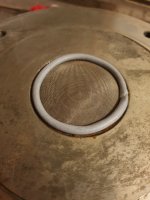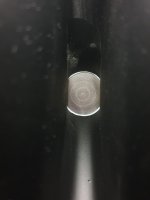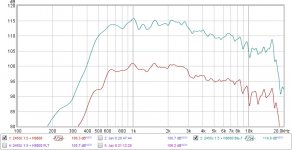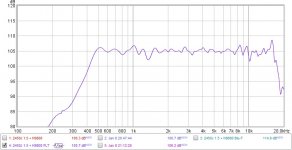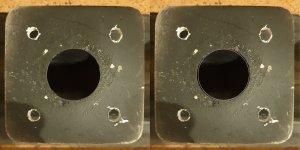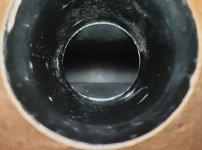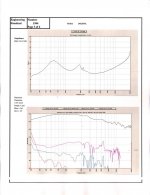I would agree that the ( maybe @ 1 7/8" to 1.5" ) mismatch has to be dealt with.
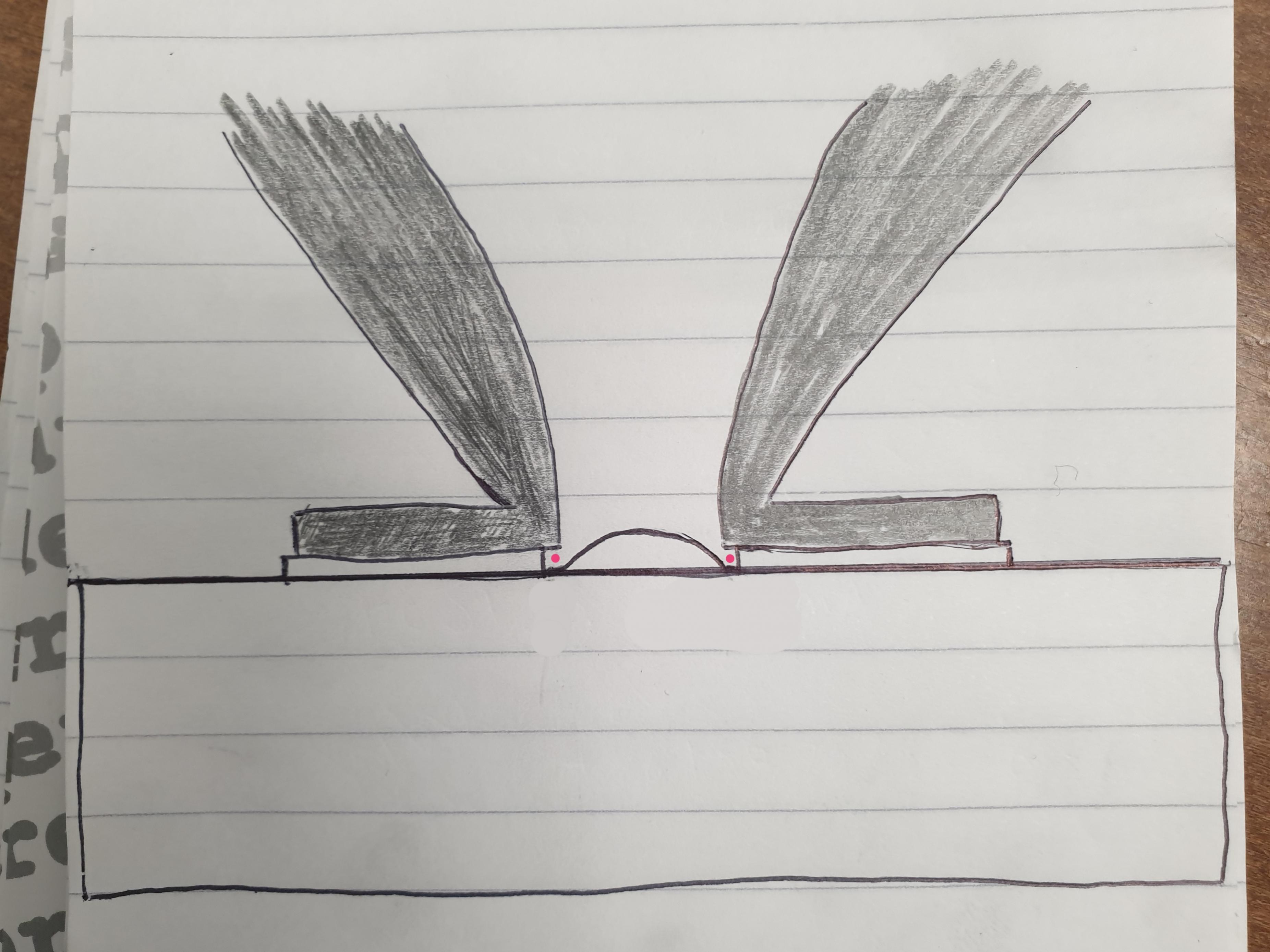
One can't have a circular well @ 1/16" deep ( caused by the overhang ) without getting measurable consequences.
Kids play-putty can fill ( and seal-off ) the gap.
🙂
One can't have a circular well @ 1/16" deep ( caused by the overhang ) without getting measurable consequences.
Kids play-putty can fill ( and seal-off ) the gap.
🙂
Last edited:
Grahamgraham, Nice job showing effects of using 1.5" horn throat and 2" aperature in post 55.
Let me get this straight, that is a 2" compression driver (opening) with an adapter to fit a 1.5" throat horn ?
Or is it a 2" compression driver on a 1.5" throated horn ? (No adapter).
Let me get this straight, that is a 2" compression driver (opening) with an adapter to fit a 1.5" throat horn ?
Or is it a 2" compression driver on a 1.5" throated horn ? (No adapter).
Grahamgraham, Nice job showing effects of using 1.5" horn throat and 2" aperature in post 55.
Let me get this straight, that is a 2" compression driver (opening) with an adapter to fit a 1.5" throat horn ?
Or is it a 2" compression driver on a 1.5" throated horn ? (No adapter).
2" CD with the beginning of the horn removed ("snout") to give access to the 1.5"ish aperture to the phase plug 🙂
A close up of a JBL4365, hope this clarifies some things.
Thanks man! So the mesh isnt really required?
Thanks man! So the mesh isnt really required?
Well, first thing that stands out is the smooth surface, free of any room between driver exit and horn. I'm also curious if you can measure a difference between getting it smooth.
Isn't the distance from the diaphragma to the mesh around (guessing!) 3-4 inches, so around 7-10 cm? Then any problems should be around 344/0.07 and 344/0.1 which mean around 4.9 KHz and 3.44 KHz, or maybe multiples of it (9.8 KHz / 6.88 KHz resp etc).
Maybe someone here has more experience on what to expect?
I always remove the mesh for home/indoor use, telling myself it sounds as a standard speaker grille: better taken out the equation.
@mterbekke my head hurts!
I got a chance to do a quick a dirty experiment with blu-tac this evening.
Turqoise/top response is with blue-tac seal.
Red/bottom response is as before just horn rested on top.
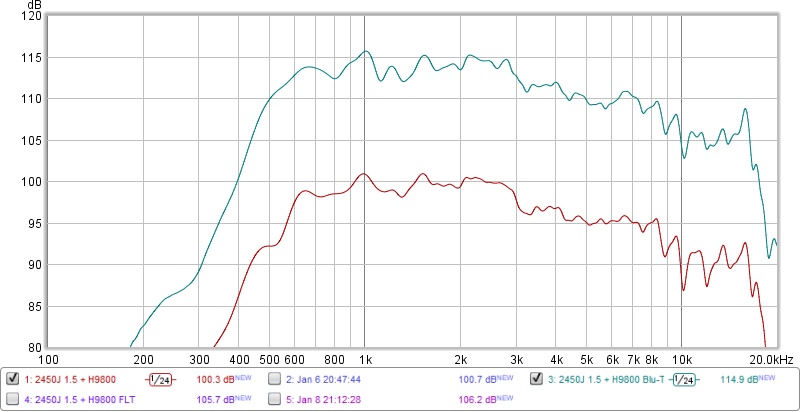
I know there is a way to go in terms of getting that mating between CD and horn perfect. Perhaps gasket tape applied to the horn flange will make a better contour especially if it is slightly too thick and forms a more solid gasket.
I EQ'd it flat for fun, it still looks choppy AF. Is this an acceptable response or am I edging closer to admitting I have bitten off more than I can chew?
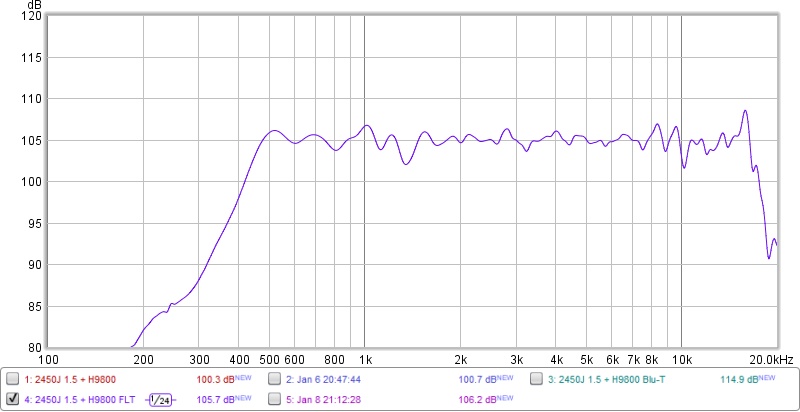
I have had such a tiring day, perhaps I should attack it when I am less likely to get as wound up!
I got a chance to do a quick a dirty experiment with blu-tac this evening.
Turqoise/top response is with blue-tac seal.
Red/bottom response is as before just horn rested on top.
I know there is a way to go in terms of getting that mating between CD and horn perfect. Perhaps gasket tape applied to the horn flange will make a better contour especially if it is slightly too thick and forms a more solid gasket.
I EQ'd it flat for fun, it still looks choppy AF. Is this an acceptable response or am I edging closer to admitting I have bitten off more than I can chew?
I have had such a tiring day, perhaps I should attack it when I am less likely to get as wound up!
Attachments
Real Progress ! I would say.
It's fantastic that you are REW savvy and can monitor how your efforts pan out .
🙂
It's fantastic that you are REW savvy and can monitor how your efforts pan out .
🙂
Is this an acceptable response or am I edging closer to admitting I have bitten off more than I can chew?
This is mostly within +- 2dB and it is not from a glossy brochure but a real-life measurement, so I would say it is very nice.
Maybe you can be convinced to use a 15" (or two) ….. 😉
regards
Charles
Instead of winging it why not just sell the 2450's and get a suitable 1.5" driver. Whole lot easier overall.
Rob 🙂
Rob 🙂
Real Progress ! I would say.
It's fantastic that you are REW savvy and can monitor how your efforts pan out .
🙂
This is mostly within +- 2dB and it is not from a glossy brochure but a real-life measurement, so I would say it is very nice.
Maybe you can be convinced to use a 15" (or two) ….. 😉
regards
Charles
Looking good!
Cheers guys, I won't give up just yet then 🙂
I would almost say it's too straight for comfort😀
Haha!
Nice!
Hehe, I think the 105db line makes it look straighter than it is! 🙂
I'm am determined to get rid of the wiggles at 8-10k! I think I know what it is, a slightly misshapen throat that I may be able to file right.
Off axis measurements and a more secure mounting to follow this weekend!
Instead of winging it why not just sell the 2450's and get a suitable 1.5" driver. Whole lot easier overall.
Rob 🙂
Well, yes, I could. But in the mean time I have the horns and I have the driver so this is costing me nothing to learn and to potentially have a wikkid good horn/CD combo at the end. It wouldn't be very DIY if I did give up tho.
Last edited:
I have found the cause of the zig-zags at 8-12k! (I think)
When the cast of the horn was made it must have been in two halves and mated so when put together there was a slight discrepancy in the thickness of the two sandwiched together about about 1-3mm. Amazing job all the same but I wonder if I can rectify this?
As can be seen below I put a pink circle inside the perimeter of the throat entry and it shows a slightly wide-screened circle.
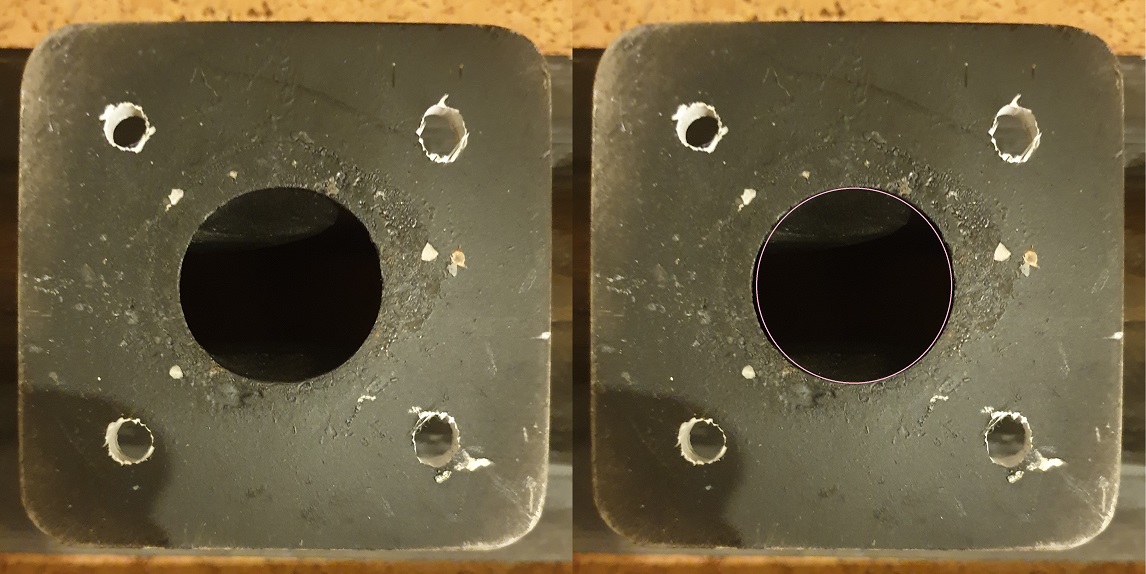
I butted the snout of the 2450J that I removed and mated it to this same throat entry and sure enough, there is overhang of 1-2mm.
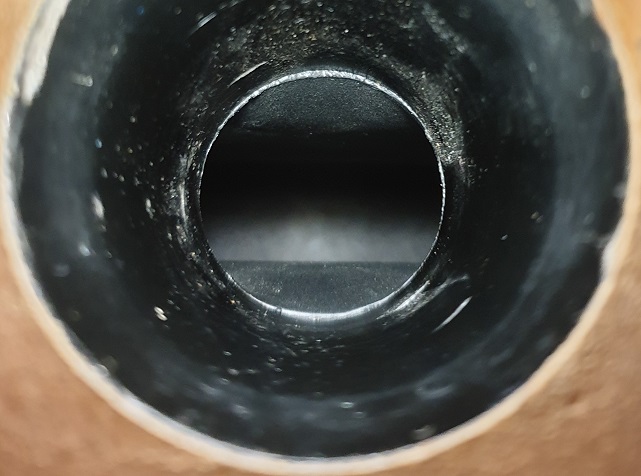
Now, does anyone think it is possible to sand these parts to match the 1.5 circular entry needed? Or will I be tampering with sensitive geometry?
I tried a 3mm foam gasket around the lip of the throat flange and the zig-zags were worse than the blu-tac mating. Unfortunately I forgot to upload those measurements when I left for work.
One of the ways I see it is that these horns have an intrinsic flaw so I can't really go wrong as that 8-12k area will never been smooth. The other way I see it is that are those zig-zags that important?
I do have an overwhelming urge to use these horns, they look sweet, they are from a very well regarded monitor that I will most likely never have the chance to own and fit the bill of what I want. But is it just a wild goose chase if they will never be perfect?
When the cast of the horn was made it must have been in two halves and mated so when put together there was a slight discrepancy in the thickness of the two sandwiched together about about 1-3mm. Amazing job all the same but I wonder if I can rectify this?
As can be seen below I put a pink circle inside the perimeter of the throat entry and it shows a slightly wide-screened circle.
I butted the snout of the 2450J that I removed and mated it to this same throat entry and sure enough, there is overhang of 1-2mm.
Now, does anyone think it is possible to sand these parts to match the 1.5 circular entry needed? Or will I be tampering with sensitive geometry?
I tried a 3mm foam gasket around the lip of the throat flange and the zig-zags were worse than the blu-tac mating. Unfortunately I forgot to upload those measurements when I left for work.
One of the ways I see it is that these horns have an intrinsic flaw so I can't really go wrong as that 8-12k area will never been smooth. The other way I see it is that are those zig-zags that important?
I do have an overwhelming urge to use these horns, they look sweet, they are from a very well regarded monitor that I will most likely never have the chance to own and fit the bill of what I want. But is it just a wild goose chase if they will never be perfect?
Attachments
Last edited:
We haven't cleaned that off after advice from a JBL forum and I haven't had time to take apart the other but here are measurements of both at 30cm with no horn. How does agreement look?
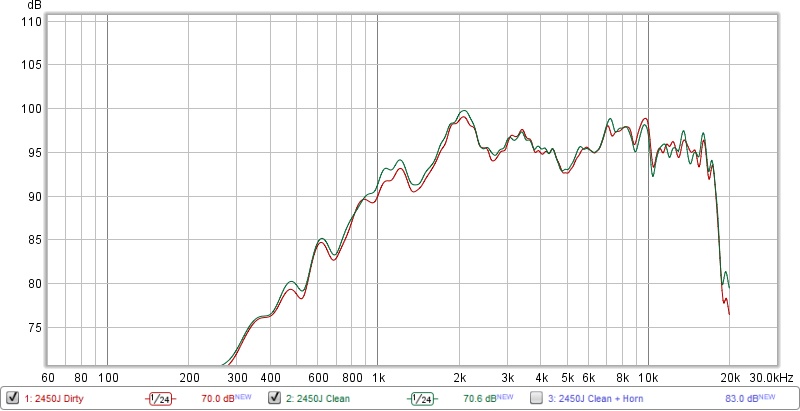
My current plan stands at:
2450J - 1000hz-18000hz ish
Twin 8" woofers per side - 100hz-1000hz ish (unless someone can really convince me)
Single Sealed SBA 8" sub per side 100hz and down
This will be until I can figure out a cheap UHF driver/horn combo. Thoughts?
1) Mesurements of Compression Drivers with NO horn make very little sense. They will be plagued by reflections from the poorly terminated "mouth" (the driver's abrupt exit), they will suffer from lack of proper loading at lower frequencies (with ensuing distortion), and they will tell you nothing about directivity. In a nutshell, they're a waste of time.
2) Using the 2450J from 1k to 18k is not ideal, i.e., it's NOT where they sound best. These are excellent MIDRANGE drivers, which really shine when coupled to LARGE horns and used over the 500-5k decade.
I EQ'd it flat for fun, it still looks choppy AF. Is this an acceptable response or am I edging closer to admitting I have bitten off more than I can chew?
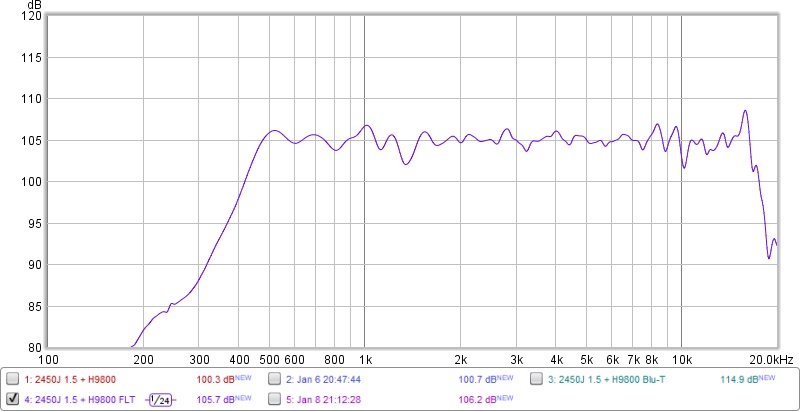
I would NOT equalise it to dead flat. It will sound harsh that way (for a multitude of reasons that I have no time to explain here).
Aim for a gently sloping FR from ~1kHz up.
Also, no matter what you do, >10kHz from the stock ribbed Ti dia is NOT going to sound refined and "high end"...
1) Mesurements of Compression Drivers with NO horn make very little sense. They will be plagued by reflections from the poorly terminated "mouth" (the driver's abrupt exit), they will suffer from lack of proper loading at lower frequencies (with ensuing distortion), and they will tell you nothing about directivity. In a nutshell, they're a waste of time.
2) Using the 2450J from 1k to 18k is not ideal, i.e., it's NOT where they sound best. These are excellent MIDRANGE drivers, which really shine when coupled to LARGE horns and used over the 500-5k decade.
1) I`m guessing the objective of the measurement at that time was different.
I don`t agree that horn drivers "suffer" anything regarding home (living room) use. You could probably steep EQ it flat to 500 Hz, ring your ears and they`d never break a sweat. If there`s no horn, there is no unloading (from a horn). Nobody at home is going to put more than a watt or so in there, I hope.
2) It`s not the driver it`s mainly the diaphragm that doesn`t support that said smooth upper end (or you`re using e.g. the old jbl 2360 horn etc). The 4365 has a cross over point of 15 K, but has a magnesium diaphragm.
If I`m not mistaken all new "high end" JBL speakers with waveguides and complementing tweeters mostly had one not because the engineers wanted them but because sales said they wanted it. Afaik none have the ribbed titanium,but not sure.
2) It`s not the driver it`s mainly the diaphragm that doesn`t support that said smooth upper end (or you`re using e.g. the old jbl 2360 horn etc). The 4365 has a cross over point of 15 K, but has a magnesium diaphragm.
If I`m not mistaken all new "high end" JBL speakers with waveguides and complementing tweeters mostly had one not because the engineers wanted them but because sales said they wanted it. Afaik none have the ribbed titanium,but not sure.
Yes and current high end drivers use aquaplas damped Magnesium or Beryllium diaphragms. The aquaplas helps smooth things out as does the non-ribbed versions. Here is a 476Mg and a 2450/2452 SL that uses a smooth coated Ti diaphragm. Both much better than the stock 2450.
And your right they needed above 20K response for their chosen market. I use a pair of 045Be tweters in my Arrays and I must say they are impressive.
Rob 🙂
Attachments
Last edited:
- Home
- Loudspeakers
- Multi-Way
- System Based Around JBL H9800 Horn
